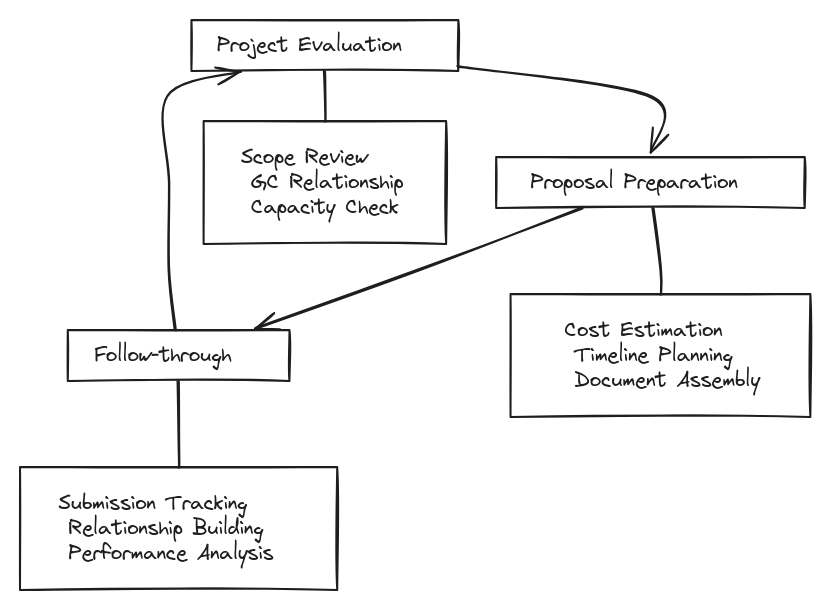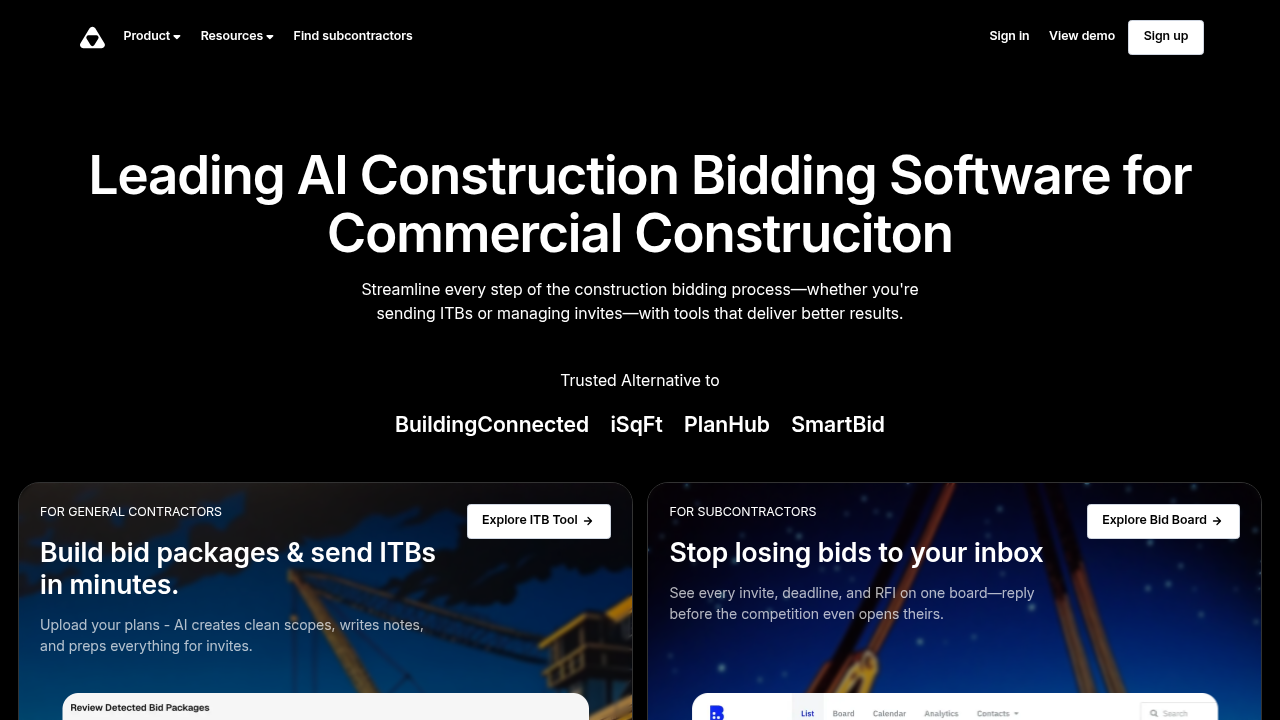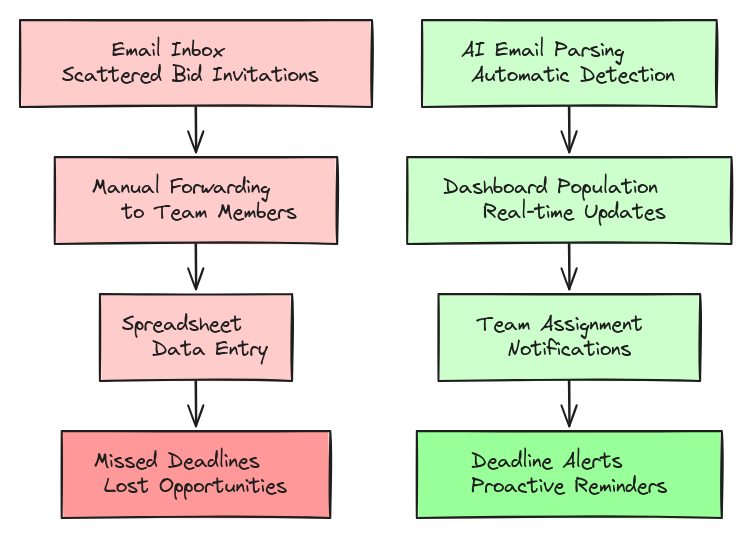Most subcontractors struggle with the same bidding nightmare: buried invitations in cluttered inboxes, missed deadlines that damage relationships, and hours wasted on manual organization instead of actual estimating. I've seen countless contractors lose winnable projects simply because they couldn't stay organized, not because their work wasn't competitive. The frustration is real when you know you could deliver excellent results but can't even get your submissions in on time. I'll show you a systematic approach to winning construction bids that eliminates the chaos and helps you focus on what actually matters: preparing quality proposals for the right projects.
TLDR:
- Automate email organization to capture every bid invite and eliminate manual data entry
- Track deadlines centrally with reminders to maintain your reputation with GCs
- Use analytics to focus on high-win-rate project types and preferred contractors
- Join verified networks like Downtobid to access 30% more qualified opportunities
- Assign team members to projects to prevent double-bidding and improve workflow
What Does Winning More Construction Bids Actually Mean?
Winning construction bids is more than submitting the lowest price. It's strategically selecting projects that match your skills, submitting quality proposals on time, and building relationships with general contractors who value your work.
A successful hit ratio in commercial construction typically runs around 5:1. That means for every five jobs you bid, you should win one contract. This benchmark helps you check whether your bidding strategy is working or needs adjustment.
The key is focusing on projects where you can deliver excellent results. Doing poor work damages your reputation far more than losing a bid ever could. Your reputation drives future invitations and referrals.
Modern bidding success requires systematic project evaluation, efficient proposal preparation, and consistent follow-through on commitments.

Strategic bidding also means understanding which general contractors prefer your work style and which project types align with your team's strengths. This knowledge helps you invest time in opportunities with higher success probability.
Why Winning More Bids Matters for Subcontractors
The construction bidding world has become increasingly competitive. High interest rates, higher material costs, and supply chain disruptions have created tighter margins across the industry. More companies are competing for fewer high-value projects.
This competition makes bid success important for business survival and growth. Winning more bids directly impacts your cash flow, letting you maintain steady work schedules and retain skilled workers. It also strengthens your market position by showing reliability to general contractors. Consistent bid wins create a positive cycle. Success with one GC often leads to invitations on their future projects. These relationships become valuable assets that reduce your marketing costs and increase your pipeline predictability.
Market positioning matters too. Subcontractors known for winning and delivering quality work get invited to better projects with more reasonable timelines and budgets. This reputation takes time to build but pays dividends through improved project selection.
A bid board approach helps subcontractors organize their opportunities and focus on winnable projects. Companies using systematic bid management report higher success rates and better project margins.
What Subcontractors Need to Win More Bids
Since general contractors review bids based on cost, contractor qualifications, relevant experience, proposed timeline, and proven understanding of project requirements, sub-contractors need to excel in all these areas to win consistently.
Cost Accuracy
Why It Matters: Competitive but profitable pricing
How to Improve: Track material costs and labor productivity
Qualifications
Why It Matters: Proven track record in similar work
How to Improve: Document past projects and certifications
Timeline Understanding
Why It Matters: Realistic schedules that work
How to Improve: Study project phases and dependencies
Project Requirements
Why It Matters: Complete scope comprehension
How to Improve: Review plans thoroughly and ask questions
To excel and win more bids, you must take a scientific, approach to success. A key element of winning bids comes from knowing what you're good at and what needs improvement. This allows you to focus on projects that align with your company's strengths, experience, and current capacity. Bidding outside your wheelhouse rarely leads to wins and can damage relationships if you can't deliver.
Tracking and reporting like this helps you focus on opportunities where you're most likely to succeed. In fact many of our customers have shared how good organizational practices in their bid management improves win rates by making sure they're focusing on the bids with the highest likelihood of success.
Build From Scratch vs Using Downtobid
Construction operates on tight deadlines. Using building a bid management system from scratch requires developing email integration, document storage, deadline tracking, analytics, and subcontractor networking features. This approach demands lots of time and technical resources that most subcontractors lack. You'd need to create systems for parsing emails, organizing project files, tracking deadlines, managing team assignments, and analyzing performance data. Each component requires ongoing maintenance and updates as your business grows.
Downtobid eliminates this complexity by providing one of the top bid management programs that connects to your existing email, automatically organizes project information, and provides access to a verified network of opportunities. The choice is clear: spend months building basic functionality or start winning more bids immediately with a proven system.

Our walkthrough here shows the simple process that gets you up and running quickly without technical headaches.
Step 1: Set up an Email Inbox for Success
Most subcontractors waste hours each week digging through email threads to find project details, deadlines, and specification updates. Important invitations get buried in spam folders or lost in cluttered inboxes. Winning bids starts with managing your inbox and multi-threaded conversations effectively.
You need to spend less time sorting through emails and more time reviewing opportunities. A centralized project view makes it easy to see what's new, what's due, and where you need to focus your attention. This organization prevents the chaos of scattered communications and missed details.

Downtobid's email integration pulls in every bid invitation from your inbox automatically, including those buried in spam folders. This gets rid of the manual data entry that wastes valuable time and makes sure no opportunity slips through the cracks. The system consolidates all bid-related emails by project, attaching spec files and showing deadlines in a single dashboard view. You can see the complete conversation history and all relevant documents without hunting through email threads. This approach changes your email from a source of stress into an organized pipeline of opportunities.
Step 2: Organize Projects by Priority and Scope
In your system, each project should have key details like deadlines, scope requirements, and GC information readily visible. This organization eliminates the confusion of scattered emails and missed details. Organization like this lets you quickly assess which projects match your skills and which ones deserve priority based on deadlines and scope alignment.
However, manual organization takes too much time and creates opportunities for errors. Important details get overlooked when you're juggling multiple email threads and document versions. Downtobid's AI parsing extracts key project details from bid documents, creating summaries that help you quickly assess each opportunity. The system identifies scope requirements, project timelines, and submission requirements automatically.
You can see at a glance which projects match your skills and which ones to focus on first. This quick assessment helps you allocate your estimating time to the most promising opportunities. The automated organization also prevents duplicate work when multiple team members receive the same invitation from different sources. Everything gets consolidated into a single project view with all relevant information attached.
Chicago contractors report major time savings from automated project organization that removes manual sorting and duplicate tracking.
Step 3: Track Deadlines and Never Miss Opportunities
Missing deadlines damages your reputation with general contractors and eliminates future invitation opportunities. Even excellent work can't overcome a reputation for late submissions. You need to see potential conflicts and plan your bid preparation accordingly. This lets you submit quality work rather than rushed proposals that rarely win.
Deadline management is important for bid winning at scale. It goes beyond simple reminders by providing context about each project's requirements and your team's capacity. With Downtobid, every bid deadline syncs to a central calendar with automatic reminders, so you never miss another submission. The system shows upcoming deadlines and provides early warnings for time-sensitive projects. This eliminates the "sorry, just saw this" scenarios that damage relationships with general contractors. You can plan your workload and allocate appropriate time for thorough bid preparation.
Our calendar view also helps you identify busy periods where you might need to be selective about which opportunities to pursue. Quality beats quantity for bid submissions.
Denver contractors use centralized deadline tracking to maintain their reputation for reliable, timely submissions that general contractors appreciate.
Step 4: Manage Team Assignments and Avoid Double Bidding
Without clear assignments, multiple team members might work on the same project or important opportunities might fall through the cracks. This waste costs time and money while potentially damaging GC relationships. You need to track progress through the bid preparation process and identify bottlenecks before they become problems. Clear ownership and accountability improve both speed and quality.
Team assignment help you balance workload across your estimating staff and make sure each project receives appropriate attention. This coordination prevents internal confusion and wasted effort. This kind of coordination improves workflow and keeps communication consistent with general contractors. Simply put, each project has a clear point person who understands the requirements and timeline.
Downtobid lets you assign estimators to specific projects and track their progress to prevent internal confusion. The system shows who's working on what projects, eliminating the risk of two people unknowingly bidding the same job. The assignment tracking also helps you balance workload across your team and identify when someone might be overcommitted. This prevents rushed work that hurts your win rate.
Houston contractors report improved team coordination and fewer internal conflicts since implementing systematic assignment tracking.
Step 5: Track Performance and Improve Your Win Rate
What gets measured gets better. Without analytics, you're bidding blind. You might continue pursuing project types where you rarely win while missing opportunities in areas where you're highly competitive.
Performance tracking provides data points that help you refine your bidding strategy and focus on the most promising opportunities. You need to understand which general contractors prefer your work, which project types align with your strengths, and how your pricing compares to successful competitors.

Downtobid's built-in analytics provide insights into your bidding performance, including win rates by GC, average bid-to-award timeframes, and trending project types in your market. These analytics go beyond basic tracking to provide actionable insights about which types of projects you win most often, which GCs prefer your work, and how your pricing compares to successful bids. This information guides strategic decisions about market focus and business development. You can invest more time in high-probability opportunities and adjust your approach for challenging market segments.
Performance data also helps you identify trends in your market and adjust your strategy accordingly. In fact, Atlanta contractors use this data to stay competitive in changing market conditions.
Step 6: Access More Opportunities Through Verified Networks
Cold calling and manual prospecting take lots of time with uncertain results.
Being part of Downtobid's network increases your exposure to new projects when general contractors use the system to send invitations. General contractors using Downtobid can easily find and invite qualified subcontractors like you, creating more bidding opportunities and stronger industry relationships. The matching system connects you with relevant projects based on your trade specialties and location. This network effect provides access to projects you might never have found through traditional channels.
Network participation also provides visibility into market trends and pricing patterns. You can see which types of projects are active and adjust your business development accordingly.
Dallas contractors report increased invitation volume through network participation.
FAQ
How do I improve my construction bid win rate?
Focus on tracking your performance by project type and general contractor to identify where you're most competitive. Most successful subcontractors maintain around a 5:1 hit ratio (winning 1 out of every 5 bids) by strategically selecting projects that match their strengths and building strong relationships with GCs who value their work.
What's the biggest mistake subcontractors make when bidding?
The most common mistake is poor organization leading to missed deadlines and scattered project information. Many subcontractors waste hours digging through email threads instead of focusing on quality estimating, which damages their reputation with general contractors and eliminates future opportunities.
When should I use automated bid management instead of spreadsheets?
If you're spending more than 10 hours per week on manual bid tracking or consistently missing opportunities due to disorganization, it's time to upgrade. Automated systems eliminate the risk of buried emails, missed deadlines, and duplicate work while providing analytics to improve your win rate.
How can I get invited to more construction projects?
Join verified contractor networks where general contractors actively search for qualified subcontractors by trade and location. Being part of these networks increases your exposure to projects you might never find through cold calling, with automatic matching based on your specialties and geographic area.
What analytics should I track to win more bids?
Monitor your win rate by general contractor, average bid-to-award timeframes, and which project types you win most often. This data helps you focus on high-probability opportunities and identify which GCs prefer your work, allowing you to allocate your estimating time more strategically.
Final thoughts on winning more construction bids as a subcontractor
The difference between struggling with scattered emails and consistently winning bids comes down to organization and focus. When you eliminate the chaos of manual tracking, you can spend your time on what actually wins projects: quality estimates and strong relationships. A systematic bid board approach changes your bidding from reactive scrambling into strategic opportunity management. Your reputation with general contractors will thank you.